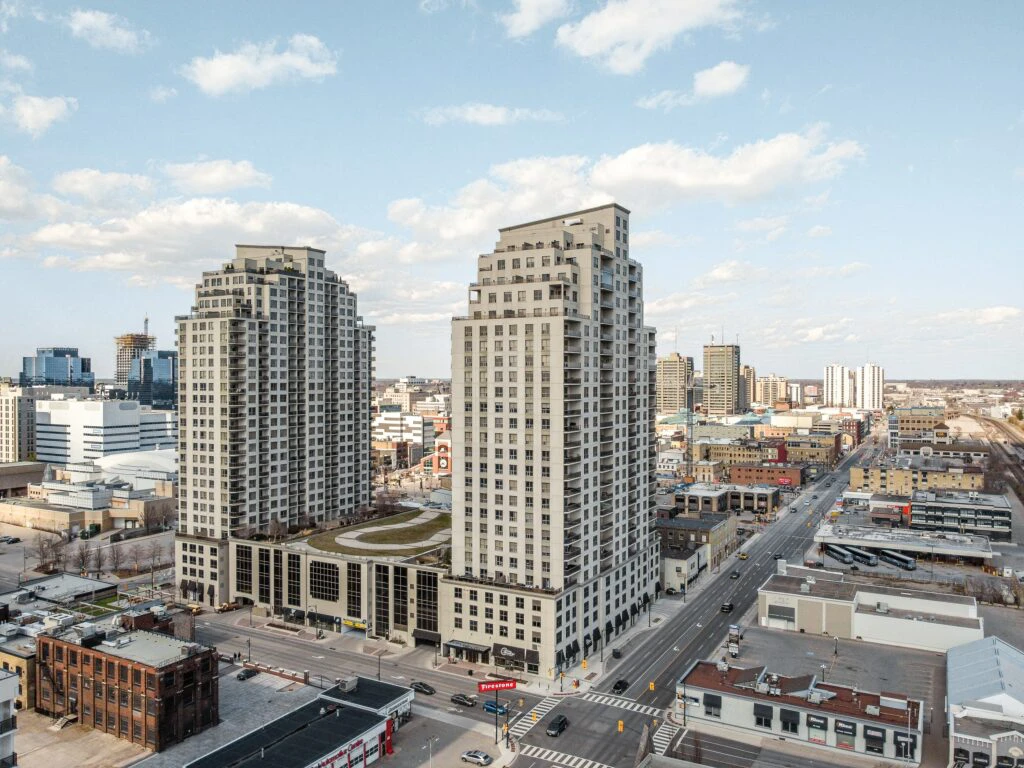An opinion piece based on historical transaction data from each of Ontario's real estate boards
Ontario Provincial Overview
Updated through the second quarter of 2025
Ontario is the largest and fastest-growing province in Canada, representing almost half of our national population and expected to surpass 20 million people over the next 25 years (37% forecasted growth). The bulk of the population is currently located in southern Ontario, specifically the Quebec-Windsor corridor which is centered by the GTA. If you don’t know what the GTA stands for, you’ve got a lot to learn.
Real estate is what’s known as a real asset, which means it provides benefit beyond any financial return on investment. That’s why we are so fortunate to live in this country; not only do we get to live in one of the most beautiful, free places in the world, Canadian homeowners have and will likely continue to enjoy a relatively low-risk but healthy return on their investment. This is no secret, explaining why close to 70% of non-homeowning millennials consider home ownership as important to them, with half of all Canadian millennials planning to purchase a home within the next 5 years.
As mortgage rates rose aggressively in 2022, our red-hot housing market went through a pricing correction and material slowdown in sales activity. With inflation now relatively under control, multiple rate cuts have been implemented but sales activity remains slower than expected. The average resale price in Ontario during the second quarter was $857K, up 1.5% from the prior quarter but down 4.5% year-over-year. With many buyers holding out for improved affordability and stabilized US-Canada trade relationship, the number of Ontario resales over the last 12 months is down 26% from the trailing 5-year average (Q3-2019 thru Q2-2024). During the second quarter, average resale prices were down year-over-year in most Ontario cities, although the provincial average price remains up 31% when compared to 5 years ago (Q2-2020). After declining to start 2024, resale inventory climbed for seven straight months as motivated sellers continued to list their properties at a faster rate than buyers are transacting. Through the first half of 2025, inventory remained elevated but stable at 4 to 5 months of supply, reflecting buyer-friendly conditions in the historical context. Mortgage renewals from pandemic-era rates may continue to aid in the current buyers market, as some homeowners may not be able to renew their covid-era mortgage at higher rates. With over 4 months of provincial resale inventory since June 2024, Ontario buyers have not had more inventory to choose from since 2013.
Almost one in four people counted during the 2021 census are or have been a landed immigrant or permanent resident in Canada. This was the highest proportion since Confederation and the largest proportion among G7 countries, with Canada expected to welcome almost 1.9 million new permanent residents between 2022 and 2025. According to Statistics Canada's recent population projections, immigrants could represent from close to one-third of the total population by 2041. There is significant demand across the world to come to Canada, and there is urgent need for municipal and provincial governments to invest in affordable housing initiatives aimed at Canadian renters and first-time homebuyers. Increased political pressure has resulted in the federal government announcing a cap on international student permits, amongst other measures such as the previously announced foreign buyer ban. These measures are intended to reduce demand but do not represent a sustainable long-term solution for our inadequate supply of homes. Other affordability measures recently announced by the federal government include the introduction of a 30-year mortgage as well as a 50% increase on the cap for insured mortgages requiring a 20% downpayment.
The Canadian Real Estate Association (CREA), through its various real estate boards and provincial associations, compiles transaction data for each of its major markets, with the CREA Stats Centre reporting sales data going as far back as 1980. While historical stats should never be the sole indicator of what’s to come, they are helpful to review and consider as part of the broader context. In this article, we will provide an update on our 5 favourite real estate markets in Ontario, alongside historical results for each Ontario market tracked by CREA.
Toronto
Toronto is the largest city in Canada and the economic and entertainment hub of our country. It is one of our most livable cities, although high home prices continue to put it at a disadvantage to other world-class Canadian cities such as Montreal and Calgary. Nevertheless, with strong immigration levels into our country and a growing population, Toronto and the surrounding GTA will continue to be a major destination.
Historically, this is why Toronto typically reports lower Months of Inventory (i.e. housing supply) than other Ontario cities. Months of Inventory (MOI), which measures how many resale homes are available for sale relative to the current buying trend, is a statistic tracked by CREA to infer how hot a real estate market may be. A lower MOI means that the number of active listings are quickly being purchased by the many more buyers that exist in the market. Going back to the start of 1992, Toronto has a median MOI of 3.0 months, compared to the province of Ontario which has a median of 3.9 months of homes available for sale.
When your market has lots of demand, you need to have lots of people selling or lots of new homes being built. Toronto has neither of these when compared to the overall demand to live in or nearby the downtown core. Add in the fact than many neighbourhoods in Toronto have limited space for new development, such as Liberty Village, and it is evident that housing affordability will remain a prominent issue for the city. After a strong start to 2024 where GTA inventory fell below 2 months, many new sellers entered the market with resale inventory spiking for six straight months to finish the year at 4.6 months. Inventory continues to grow in 2025, climbing to 4.8 months in the first quarter and firmly in buyer-friendly conditions at 5.0 months in Q2-2025. Toronto buyers are waiting out sellers, with a glut particularly in condo listings, now close to triple the supply when compared to the trailing 5-year average.
During the second quarter of 2025, the Greater Toronto Area reported an average sale price of $1,110K, down 4.4% from a year ago and only up 2% from the trailing 5-year average. Across all regions comprising the GTA (York Region, Mississauga-Peel, Halton, Durham, etc.) the core Toronto municipality, which suffered somewhat of an exodus during the pandemic, remains challenged for price growth and featuring more inventory than the historical average. For more information on the Toronto housing market, specifically the Toronto municipality comprising Etobicoke and Scarborough boroughs, check out the latest Toronto Market Report here.



London
Two hours west of the GTA, two hours east of Windsor-Detroit, and 45 minutes from two Great Lakes, London is the hub of southwestern Ontario, with major companies, hospitals, and higher education based in the city. Across Western University and Fanshawe College, London’s population grows by 50K students every September through April, with many of these students choosing London as their new home upon graduation. This is a big reason as to why the London rental market has historically been one with very low vacancy rates, with a recent Statistics Canada report showing 86% of all apartments in London being owned by investors. This is significantly higher than what the report found for nearby markets of Kitchener-Waterloo (61.5% investor-owned) and Toronto (36.2%). London is a large and fast-growing market, the 11th largest in Canada, with its population up 10% since the 2016 census. This population increase is close to double Ontario provincial growth of 5.8% during the same time period. As affordability across the GTA becomes more and more out-of-reach for first-time buyers, London should continue to see increased demand driven by GTA migration.
In the second quarter of 2025, the London and St. Thomas board reported an average sale price of $654K, up 2% from the prior quarter but down 1% year-over-year. When compared to trailing 5-year average, now centered around the market peak of late 2021 and early 2022, London resale prices are only up 3%, slightly outperforming the provincial average which is flat.

At the end of 2023, London reported 4.7 months of inventory, slightly higher than inventory levels one year earlier and much healthier than the trailing 5-year average for the region. Like other markets in Ontario, after supply fell in early 2024, inventory has steadily crept back to buyer-friendly conditions, with London reporting 4.4 months of supply in Q2-2025.
For more information on the Greater London Area, comprising London and surrounding Middlesex County, St. Thomas and Elgin County, Strathroy-Caradoc, Woodstock-Ingersoll, and Tillsonburg and Norfolk County, check out the latest London Market Report here.

Thunder Bay
Thunder Bay, like London and Toronto, is the hub of its greater region of Northwestern Ontario. While not home to nearly as many people, it should continue to grow in prominence alongside other hub cities in Canada. For those who don’t know Thunder Bay, it is the most populous city on the shores of Lake Superior, with its vast waterfront and surrounding nature making it one of the most spectacular landscapes in our country. It is also known for its harsh winters, but if you’re a fan of the great outdoors, Thunder Bay has a lot to offer. As a hub city, Thunder Bay’s economy has a mix of manufacturing, primarily relating to the area’s vast natural resources and lake access, and services such as healthcare, banking, and education. It is home to two premier Canadian post-secondary institutions: Lakehead University and Confederation College, with Lakehead recently expanding into southern Ontario with a permanent satellite campus in Orillia.
A final reason it's on our list of favourite markets in Ontario is its relative affordability. Thunder Bay is more remote than southern Ontario: 1 hour from the Minnesota border but more than 7 hours to its nearest Canadian cities of Winnipeg and Sault Ste. Marie. For this reason and its harsh winter climate, average prices in Thunder Bay are now around $400K. When considering that summers in Thunder Bay can get as hot as anywhere in southern Ontario, the chance of trading in your beautiful, but small, Muskoka cabin for your dream recreational property, you can understand why many people are relocating to Thunder Bay or considering doing so. This is all made more possible with the Covid-19 acceleration towards the hybrid-work model of the future.
When rate hikes began in 2022, Toronto, London, and most markets in Southern Ontario saw price declines while average prices in Thunder Bay were more or less flat. In 2023 and extending throughout 2024, buyer demand driven by relative affordability has remained strong with inventory levels still in line with Thunder Bay’s trailing 5-year average of around 3 months of supply. Since April 2024, most cities in Ontario are reporting rising inventory levels into buyer-friendly territory, but Thunder Bay has bucked the trend. During an active second quarter, Thunder Bay reported 2.2 months of resale inventory, half the relative supply when compared to the province and lower than all other markets in Ontario.
Resale activity in Thunder Bay continues to outperform the GTA and the province, with units sold over the last 12 months flat when compared to the trailing 5-year average. With a sharp rebound in average price recorded during the second quarter, prices are up 9% year-over-year. As our country continues to grow, it will be interesting to track Thunder Bay's progress as a more prominent Ontario hub market.

Cornwall
Cornwall is the smallest market on this list, with a population of just under 50K as of the 2021 census. However, in the broader context, it is surrounded by multiple large - and more expensive - cities. Montreal is a 90 minute drive, while Ottawa is just over an hour away. When compared to regular GTA traffic, those commutes are not unreasonable.
Beyond Montreal and Ottawa, 5 hours to the west is the GTA, while 7 hours south lie the Boston and New York metros. These five population centres are home to more than 35 million people, and many of them will consider relocating at some point in their lifetime. They are also fantastic places to visit for those in Cornwall that aren’t opposed to a few hours of driving.
If the big city isn’t your preference, Cornwell locals are less than 3 hours away from the beautiful villages of Mont-Tremblant and Prince Edward County. From a lifestyle perspective alone, there is a lot of attraction within a short to medium weekend drive.
Long-term, Cornwall’s strategic location will place upward pressure on its relatively small housing supply. This has already been happening to a certain extent, with average resale prices in Cornwall significantly outpacing the provincial average over the last 5 years. When compared to the weighted average resale price over the past 5 years, Cornwall is up 16%, while the Ontario provincial average is flat. Despite the pullback from the record peak observed in early 2022, Cornwall prices in Q2-2025 are up 60% compared to five years ago, double the Ontario average of 31%. Even when factoring in this recent growth, Cornwall prices remain extremely affordable for southern Ontario, ending the year with an average price of $533K. This bodes well for its future growth.
In 2024, buyer demand picked up, with resale prices increasing in each of the first three quarters to finish up 6% year-over-year. Prices continue to tick up in 2025, up 3% from the first quarter and 5% year-over-year. To start the year, inventory levels were higher than the provincial average at 5.4 months, up from 4 months supply during the first quarter of 2024. With significantly better affordability than neighbouring cities, these favourable buyer conditions were not likely to last long. An active second quarter for buying activity pushed Cornwall resale supply back into a seller's market at 2.9 months, down 10% year-over-year.

Ottawa
Ottawa, alongside Gatineau in Quebec, forms the National Capital Region. The two cities are home to the federal government and a multitude of public-sector organizations. With a population of 1.5 million, it is one of the largest and fastest-growing markets in Canada, with close to 10% growth since the 2016 census. As our country continues to grow and become more prominent on the world stage, this market should continue to benefit from its robust service-based economy.
Ottawa is two hours from Montreal, but as my friend Dylan likes to mention every time I come visit, Ottawa is a world-class entertainment city of its own. The city is home to multiple post-secondary institutions, professional sports teams, and is a short-drive from beautiful landscapes and freshwater lakes in nearly every direction. For these reasons and many others, Ottawa prices are up 35% compared to 5 years ago.
In the second quarter of 2025, the Ottawa board reported an average sale price of $734K, up 7% from the prior quarter and 4% year-over-year. Resale supply sits firmly in seller market territory, ending the second quarter at 2.6 months. Nonetheless, Ottawa buyers still have a month more supply when compared to the trailing 5-year average.
Other Highlights
Since March 2022, the sharp rise in interest rates has resulted in falling average prices and more balanced inventory levels. In 2022, only five Ontario markets had positive growth in their average resale price, with most of them being hub cities in more remote regions of Northern Ontario (Thunder Bay, Timmins, and Sault Ste. Marie, alongside Sarnia and Kingston). During 2023, prices stabilized, with only 10 of 45 provincial board regions reporting year-over-year price declines. Stabilized prices continued in 2024, with only 11 of 45 markets down year-over-year, 10 of which saw minor declines of less than 6%.
Another general trend for Ontario: prices are up from pre-pandemic levels but down from the covid peak of early 2022. Every board region in the province ended the second quarter of 2025 with a higher sale price than the full-year 2019 average, with the smallest increase recorded in Mississauga at +31%. The largest price gain compared to 2019 is in North Bay, with resale prices nearly double (+95%). However, when Q2-2025 prices are compared to the market peak of Q1-2022, the median price decline is 17% with a select few markets showing price gains, led by Thunder Bay and Timmins at +18%.
Every market is different, but understanding available inventory levels alongside recent price and market trends can help prospective buyers and sellers make more informed decisions. A summary of all Ontario markets through the second quarter of 2025, sorted by largest to smallest for overall units sold, is presented below. Stay tuned for the Q3-2025 update of the Ontario Market Report in October.


At Royal LePage, we are the largest Canadian real estate company, with close to 20,000 licensed realtors across the country. In Thunder Bay, Royal LePage Lannon is the market leader, advising on more than 30% of all transaction volume and recently winning the A.E. LePage Brokerage of the Year award. If you are looking to learn more about a particular market, historical transaction stats coupled with an agent specialized in your property type and location is a great way to do so.
Thank you for taking the time to read this article. As you contemplate the next steps in your real estate journey, there are a variety of helpful online resources you can leverage, such as realtor.ca, the Canadian Mortgage and Housing Corp, and historical sales data and market insights from leading real estate websites like Zolo, Royal LePage, HouseSigma, and Wahi.
ABOUT THE AUTHOR
John Peloza has held his Ontario Realtor® license since April 2021 and has held the Chartered Financial Analyst® designation since 2018. Upon graduating from the Ivey School of Business, John spent time in market research and consulting roles before beginning his career in real estate in 2017 as a Financial Analyst with Royal LePage Canada. During his time at Royal LePage, he supported on consulting engagements with parent company Brookfield, culminating in a secondment at digital brokerage start-up Wahi, which has been based in Toronto since November 2021.
John's primary markets of interest include the Toronto harbourfront, Liberty Village and Queen West neighbourhoods, his hometown of London Ontario, and the Leamington-Kingsville region of Essex County. He is passionate about real estate, wealth management and personal investing, and helping clients achieve their goals through education and expertise.







